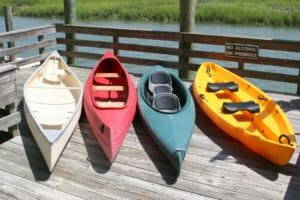Types of Canoes

Types of Canoes

Okay, so you’ve decided to buy a canoe. Whether you’re a beginner to the sport, or a seasoned paddler, the variety of brands, types and models of canoes on the market today can be a bit overwhelming.
The modern canoe has come a lot way from its original skin-on-frame ancestors, and so have the possibilities. The lines between canoes and kayaks have blurred in recent years, and some canoes have covered decks and enclosed cockpits and look nothing like your grandfather’s strip built wooden canoe.
When shopping for a canoe, the first place to start is by deciding what you’ll be using it for. Do you just want a recreational canoe for fishing or to take a few passengers out for a relaxing afternoon on the water? Or do you have more specialized plans, such as solo touring or whitewater canoeing? Will most of your paddling be done on calm ponds and lakes, or will you be tackling more challenging river water? Just keep in mind that a recreational boat will do a lot of things pretty well, but the more specialized canoes are intended to do just one thing, but do it very, very well.
Not all canoes are created equal, and a boats handling and performance are a function of its design, and especially the design of its hull. The shape of the hull, both below and above the water line, greatly influence how it behaves. A canoe with more rocker, for example, will be easier to maneuver, but won’t track as well in a straight line. Everything is a trade-off, and a performance canoe designed to go fast will have a much different width, length and rocker than a recreational canoe designed to take the family out on a quiet fishing excursion.
Once you taken all these factors into account, you’ll have a better idea of the type of canoe that will best suit your needs (and your budget). And don’t forget the portability factor. If you plan on doing a lot of solo paddling, for example, do you really want to be lifting a long heavy canoe on and off the roof of your car without a partner around to help you?
So without further ado, here’s our short list of major canoe types in no particular order:

Recreational Canoes
As the name suggests, these canoes are intended for everyday, recreational use. These are typically the most versatile type of canoe, and they can be used for wide variety of on-water activities, including fishing, hunting, hiking, photography, casual paddling, and more. They have room to seat two or more paddlers, plus plenty of stowage for your gear.
Recreational canoes are typically flatwater boats, with little or no rocker, with thin ends and an asymetric hull. They’re stable and easy for even beginners to handle. These recreational canoes aren’t going to have the performance features of the more specialized canoes, but they’re usually the best choice for families and weekend paddlers of all skill levels.

Touring or Tripping Canoes
Touring canoes are intended to be paddled longer distances, and carry enough gear for overnight or multi-day excursions. In North America, touring canoes are usually straight tracking boats will little rocker for navigating wind-blown lakes and other large bodies of water. They’re stable, efficient and can be maneuvered fairly easily, and will haul enough gear and food for a small family to camp out for several nights.
A “tripping canoe,” on the other hand, is a slightly different design. Trippers typically have more rocker than touring boats, and so are more maneuverable on whitewater rivers. They also don’t track as well on wind-blown flatwater, especially when lightly loaded. They require more paddling skill as well. Another design feature of trippers is that they’re usually made of tougher and heavier materials, making them stronger, but also more work to portage to and from the water.
Sporting Canoes
As you might imagine, these are specialized canoes designed for performance on the water. Whitewater canoes are a popular type of sporting canoe. These boats have a lot of rocker so they can turn on a dime, allowing for playboating-like tricks in rapids. This extreme rocker also makes for a more stable boat. By lifting each end of the canoe out of the water, more of the wider center section of the boat is in the water, adding to overall stability (but also making it a poor-tracking boat on windy flatwater ponds and lakes).
These canoes are for more skilled and experienced paddlers, and the novice should get some experience paddling a more conventional boat before hitting the water water in a specialized canoe.
Some of these wastewater canoes have decks just like a kayak, and in fact look very much like a kayak to the untrained eye. They can even be equipped with flotation bags like a kayak. But the paddler operates these canoes from the standard kneeling position, and uses a single-bladed paddle just as in a traditional canoe.
[box] Return from Types Of Canoes to Kayaking Journal Home Page[/box]
